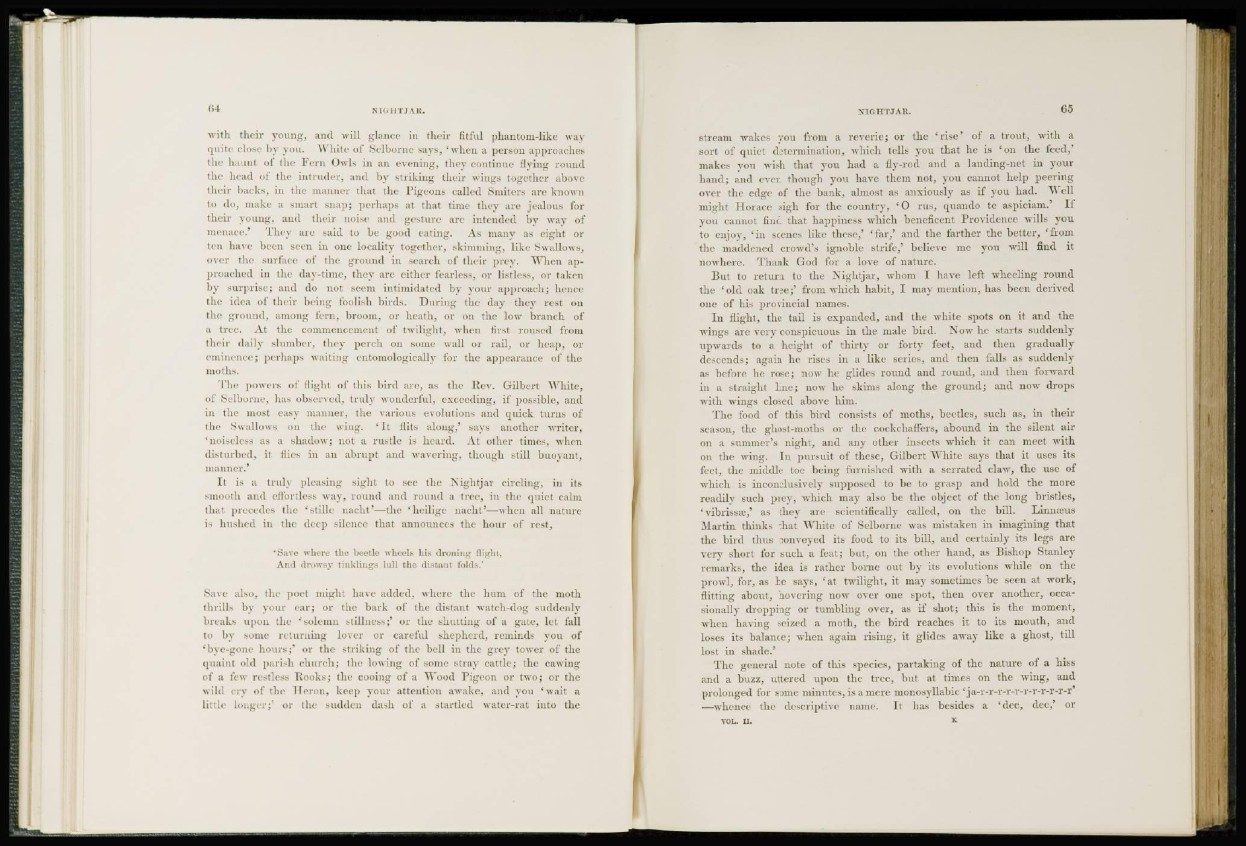
with their young, and will glance in their fitful phantom-like way
quite close by you. \\ lute of Selborne says, 'when a person approaches
the haunt of the Fern Owls in an evening, they continue flying round
the head of the intruder, and by striking their wings together above
their hacks, in the manner that the Pigeons called Smiters are known
to (In. make a smart sua]); perhaps at that time they are jealous for
their young, and their noise and gesture are intended by way of
menace.' They are said to he good ealbig. As many as eight or
ten have been seen in one locality together, skimming, like Swallows,
over the surface of the ground in search of their prey. When approached
in the day-time, they are either fearless, or listless, or taken
by surprise; and do not seem intimidated by your approach; hence
the idea of their being foolish birds. During ihe day they real on
the ground, among tern, broom, or heath, or on the low branch of
a tree. At the commencement of twilight, when first roused from
their daily slumber, they perch on some wall or rail, or heap, or
eminence; perhaps waiting cutomologically for the appearance of the
moths.
The powers of flight of this bird are, as the Rev. Gilbert White,
of Selborne, has observed, truly wonderful, exceeding, it' possible, and
in the most easy manner, the various evolutions and quick turns of
the Swallows on the wing. 'It flits along,' says another writer,
'noiseless as a shadow; not a rustle is heard. At other times, when
disturbed, it flies in an abrupt and wavering, though still buoyant,
manner.'
It ia a truly pleasing sight to sec the Nightjar circling, in its
smooth and effortless way, round and round a U-ee, in the quiet calm
that precedes the 'stille nacht'—the 'heilige nacht'—when all nature
is hushed in the deep silence that announces the hour of rest,
'Save when the beetle wheels his droning flight,
And drowsy tinkliugs lull the I nut folds.'
Save also, the poet might have added, where the hum of the moth
thrills by your ear; or the bark of the distant watch-dog suddenly
breaks upon the 'solemn stillness;' or the shutting of a gate, let fall
to by some returning lover or careful shepherd, reminds you of
'bye-gone hours;" or the striking of the hell in tin grey tower id' the
quaint old parish church; the lowing of some stray cattle; the cawing
of a few restless Rooks; the cooing of a Wood Pigeon or two; or the
wild cry of the Heron, keep your attention awake, and you 'wait a
little longer;' or the suddeu dash of a startled water-rat into the
stream wakes you from a reverie; or the 'rise* of a trout, with a
sort of quiet determination, which tells you that he is 'on the feed,'
makes you wish that you had a fly-rod and a landing-net in your
hand; and even though you have them not, you cannot helj) peering
over the edge of the bank, almost as anxiously as if you had. Well
might Horace sigh for the country, ' 0 rus, quando te aspiciam.' If
you cannot find that happiness which beneficent Providence wills you
to enjoy, 'in scenes like these,' 'far,' and the farther the better, 'from
the maddened crowd's ignoble strife,' believe me you will find it
nowhere. Thank God for a love of nature.
But to return to the Nightjar, whom I have left wheeling round
the 'old oak free;' from which habit, I may mention, has been derived
one of his provincial names.
In flight, the tail is expanded, and the white spots on it and the
wings are very conspicuous in the male bird. Now he starts suddenly
upwards to a height of thirty or forty feet, and then gradually
descends; again he rises in a like series, and then falls as suddenly
as before he rose; now he glides round and round, and then forward
in a straight line; now he skims along the ground; and now drops
with wings closed above him.
The food of this bird consists of moths, beetles, such as, in their
season, the ghost-moths or the cockchaffers, abound in the silent air
on a summer's night, and any other insects which it can meet with
on the wing. In pursuit of these, Gilbert White says that it uses its
feet, the middle toe being furnished with a serrated claw, the use of
which is inconclusively supposed to be to grasp and hold the more
readily such prey, which may also be the object of the long bristles,
'vibrissa1/ as they are scientifically called, on the bill. Limueus
Martin thinks that While of Selborne was mistaken in imagining that
the bird thus conveyed its food to its bill, and certainly its legs are
very short for such a feat; but, on the other hand, as Bishop Stanley
remarks, the idea is rather borne out by its evolutions while on the
prowl, for, as he says, 'at twilight, it may sometimes be seen at work,
flitting about, hovering now over one spot, then over another, occasionally
dropping or tumbling over, as if shot; this is the moment,
when having seized a moth, the bird reaches it to its mouth, and
loses its balance; when again rising, it glides away like a ghost, till
lost in shade.'
The general note of this species, partaking of the nature of a hiss
and a buzz, uttered upon the tree, but at times on the wing, and
prolonged for some minutes, is a mere monosyllabic 'ja-r-r-r-r-r-r-r-r-r-r-r'
—whence the descriptive name. It ha> besides a 'dec, dec,' or
VOL. II. K